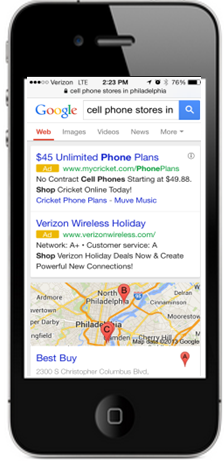
There’s no question – telecommunications SEO is a niche with established and aggressive players. That makes for some fierce online competition. Here are 5 of the most important SEO considerations for telecommunications companies as they battle to compete in online marketing.
1. Keyword verticals & targeting
Sure, it sounds tempting to try and rank for “cell phones” or “iPhone” – but are these informational keyword phrases really going to drive revenue? The intent of the searcher behind these phrases is incredibly ambiguous, even if the traffic levels are high.
Telecom companies must look beyond the attractive-seeming head phrases and turn their eye to keywords that show customers are lower in the funnel and hunting for information with intent. For example:
-
Generic queries like “iPhones” or “Android Phone” are informational queries that may have nothing to do with commercial intent. One may be searching for apps, prices, locations for on conversions.
-
Broad informational queries like, “best cell phones” or “which mobile phone is fastest?” indicate the searcher is likely in the discovery phase. They may not need a phone or phone plan right away, but are indicating interest in a potential future purchase.
-
Phrases containing “cheap” (ie: Cheap cell phone plans) would indicate the user is comparison shopping for providers based on price. We can infer that they are likely in need of a new plan or are ready to switch.
-
Phrases containing “reviews” (ie: AT&T reviews, iPhone 4 reviews) indicate a consumer who is comparison shopping based on reputation; again, they are likely preparing to make a purchase.
-
More specific queries like, “White iPhone 4S” or “Nokia Lumina 521 plans” would indicate a high intent to purchase as the user has narrowed down their options, while a phrase like “buy cell phone plans online” or “free shipping Nokia Lumina” indicates absolutely that the searcher is prepared to buy.
Telecommunications SEO should prioritize strategies to target phrases at every stage of the funnel: discovery, evaluation and purchase.
Further, keyword verticals should be all-encompassing: plans, deals, branded phrases, phone models, sales locations, question-based queries and FAQ’s are all potential traffic and revenue opportunities.
2. Website Structure
Smart phone and telecommunications providers feature a ton of information on their sites – products, plans, locations, deals and more. Without the right architecture, your content may never be found – not by search engines, or users. It’s incredibly important to tie together a slick user experience and easy navigation to search engine best practices. A qualified telecommunications SEO agency will be able to marry beautiful design with SEO-friendly structure, also ensuring that your content can be easily updated and managed as your site inevitably changes with time.
3. Permanent & Unique Content
The websites of smart phone carriers seem to be ever-evolving as new marketing campaigns, phones and accessories, plans and buying incentives come to market. As such, much of the content on their website is short-term in nature. The trouble is, Google takes time to index and rank content. And, if content is constantly switching pages or disappearing from the web then link building efforts may be ineffective or wasted with the death of the page. For highly competitive, short-tail phrases like “cell phone deals”, long-term content is almost always a must.
Also important is that the content be unique. It’s not enough to copy the manufacturer’s descriptions of their products or duplicate the content found elsewhere on the web.
Telecommunications companies need to have a plan for providing long-term, more permanent content that won’t disappear from the web. The site’s architecture and content strategy must reflect this for SEO to be effective.
4. Mobile & Responsive Websites
It may sound obvious, but it’s often overlooked (just 6% of fortune 500 companies adhere to Google’s recommendations on the matter). The websites of mobile providers should be easily accessible through mobile devices. After all, 46% (and climbing) of consumers use mobile internet exclusively – no desktops to speak of.
Designs should be responsive and streamlined; content should be easy to consume on a smaller screen. Google’s recommendation is responsive websites, but when this isn’t possible, device-specific HTML is your next best option.
This is even more important as mobile providers will be expected to “walk the talk” when it comes to mobile experiences.
5. Local SEO
Most major telecom providers also have kiosks and brick-and-mortar stores on the ground at which they sell phones and plans. There’s significant search volume surrounding phrases like “cell phone stores in Philadelphia” or “Buy a phone in Miami” – and these kinds of results trigger local listings as part of their results. Further, these local queries indicate a high intention to buy.

While the task is daunting, a local strategy can be created to claim and optimize local listings, build citations (instances of the store’s name, address and phone number across the web) as well as generate and respond to reviews.